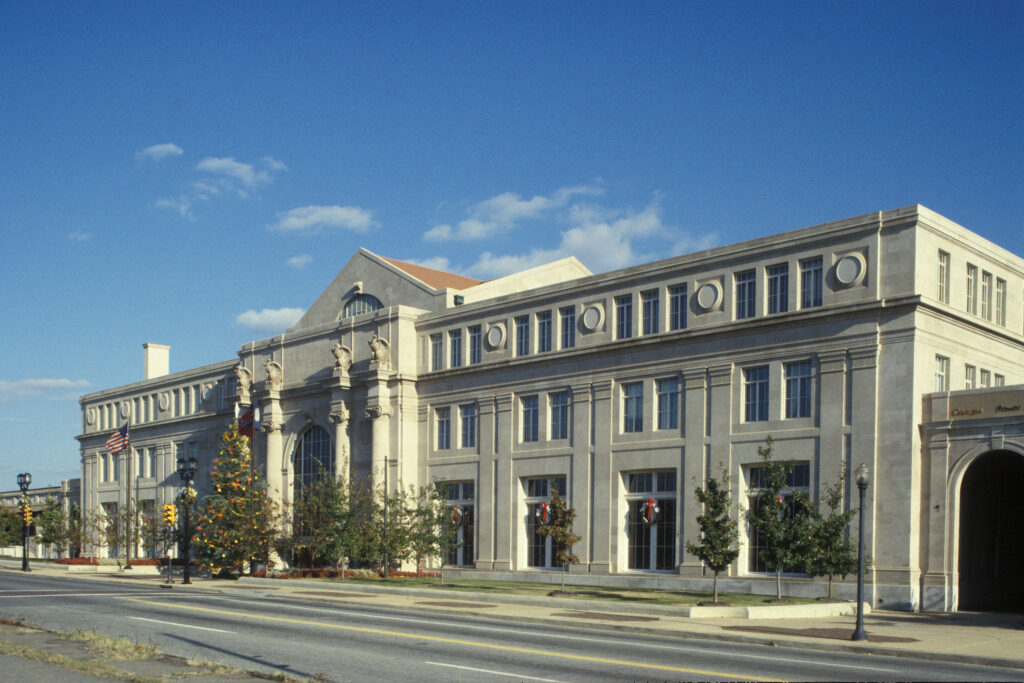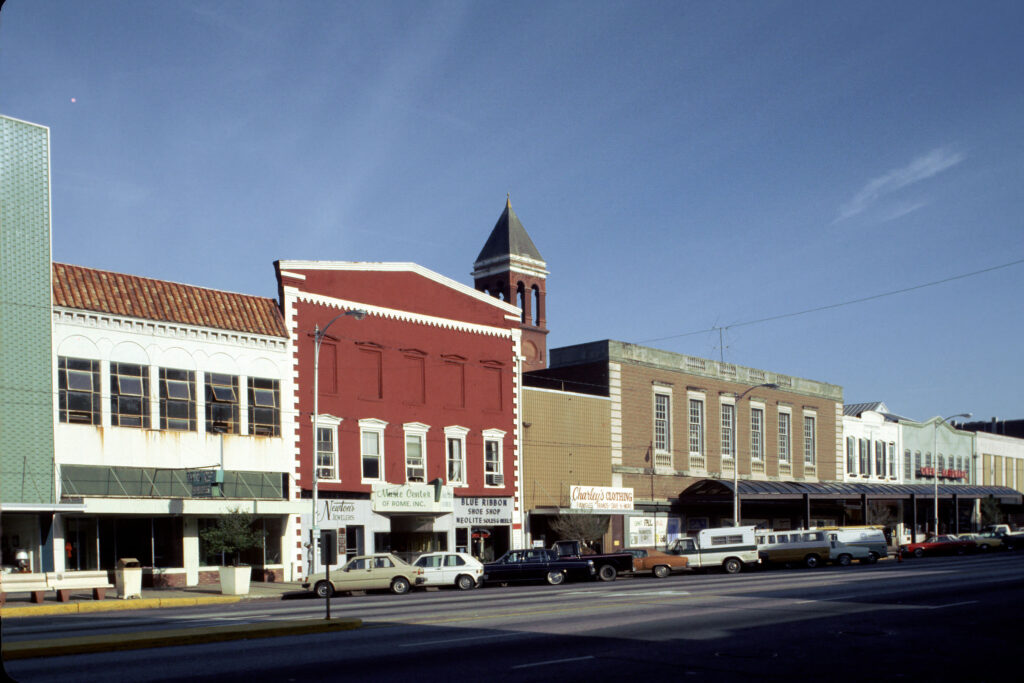Historic preservation officially began in Georgia in the aftermath of World War II (1941-45), when growing prosperity led to new development that threatened to destroy the state’s historic environment. Along with several other states in the 1950s, Georgia established a program, the Georgia Historical Commission (GHC), to mark places with historical associations. About the same time, the Historic Savannah Foundation, created in 1955 in response to the loss of a beloved city market, set about to save that city’s unique environment of row houses and squares and bring back to life large abandoned areas of its downtown.
Georgia in a National Historic Preservation Program
In 1969 the GHC, spurred by the passage of the National Historic Preservation Act of 1966 (NHPA), expanded in a new direction that event ually led to today’s multifaceted preservation program. The commission’s executive director became the first state historic preservation officer, and the GHC became involved in surveys of historic and archaeological resources, entries to the National Register of Historic Places, historic building rehabilitation grants, preservation planning, and community preservation assistance. In 1973, when the GHC was abolished in a reorganization of state government, the new Department of Natural Resources assumed responsibility for its programs.

Courtesy of Historic Preservation Division, Georgia Department of Community Affairs.
Also in 1973, in response to concern for the future of the public program and to increasing interest in historic preservation, the nonprofit Georgia Trust for Historic Preservation (GTHP) was founded. It has become the largest statewide preservation organization in the nation and one of the strongest. Existing preservation organizations, in cities large and small, grew and were joined by a myriad of new groups, numbering more than 500 by 1996. In 1979 a special issue of the Georgia Historical Quarterly dedicated to historic preservation recorded the developments of these early years.
Georgia Preservation Comes of Age
In 1980 two key pieces of legislation, one state and the other federal, stimulated the growth of Georgia’s preservation programs. The Georgia Historic Preservation Act, passed through the advocacy efforts of the growing body of interested and active citizens, provided the authority for local historic preservation commissions. By 2000 there were eighty-seven such commissions in the state. The 1980 amendments to the NHPA set up the formal structure that now constitutes the Historic Preservation Division of the Georgia Department of Natural Resources. The GTHP, a key advocate for the 1980 state legislation, grew and began to achieve the financial stability that would allow it to support new programs.

Courtesy of Historic Preservation Division, Georgia Department of Community Affairs.
Since that time Georgia’s historic preservation movement has continued to succeed both in protecting resources that are now recognized to be a significant part of Georgia’s history and in attracting more people who are interested in preserving them. The importance of African Americans in Georgia’s history was highlighted in 1984 with the publication of Georgia’s Black Historic Resources, a handbook that has received national attention. In 1989 the Georgia African-American Historic Preservation Network was launched at a meeting in Macon. The Historic Preservation Division began to showcase resources and tourism opportunities and to support local preservation activities. The movement also benefited from a growing awareness of the economic benefits of preservation. Several important studies and legislative committees examined the economic effects of tax incentive and grant projects, Main Street programs, and tourism promotions. Heritage education programs, coordinated and supported by GTHP since 1991, continue to grow.

Courtesy of Historic Preservation Division, Georgia Department of Community Affairs.
Opportunities also came from unexpected sources. In 1992 Congress passed a transportation bill that provided enhancement funding for historic and natural resources associated with transportation routes and facilities. Many Georgia towns used this funding to restore railroad depots, improve streetscapes in historic downtowns, restore community landmarks adjacent to road rights-of-way, and create trails and bikeways. Even disastrous events like the floods of 1994 had some positive consequences: they brought emergency funds and technical assistance to many communities whose historic areas and identity were swept away by the floodwaters. Historic preservation offered a way to reconnect people with their past through rebuilding their damaged resources. Out of tragedy came not only rehabilitated downtowns and buildings but also improved working relationships among federal, state, and local agencies and a disaster plan that has been a national model.
A New Millennium
Early in the 1990s two pivotal events strengthened Georgia’s preservation programs for the new millennium. Both were made possible by a growing citizens’ advocacy movement that influenced study committees of the Georgia legislature as well as state government and especially emphasized the economic benefits of historic preservation. First, a group of preservation leaders, led by the chair of the GTHP, persuaded the governor to begin a small grant fund for historic property rehabilitation, called Heritage 2000, which has slowly grown. This was followed by the elevation of the state historic preservation program to full division status within the Department of Natural Resources. This gave the program increased resources and influence that has greatly benefited historic preservation in Georgia.

Courtesy of Historic Preservation Division, Georgia Department of Community Affairs.
Georgia’s preservation system, like the nation’s, may not be neatly structured and obvious. It is, however, built on an extensive, strong network of public state and local programs complemented by continually growing state and local nonprofit organizations. Many of Georgia’s programs, innovative projects, and leaders have been nationally recognized. The basis of Georgia’s success has been its achievement in developing and carrying forward the premise of the NHPA: that the nation’s history should be preserved as a “living part of our community life and development.”






















